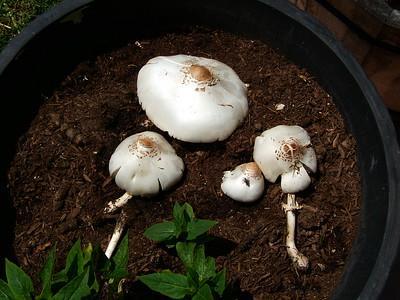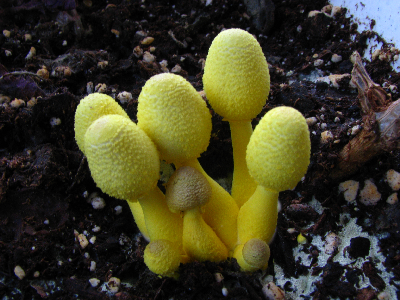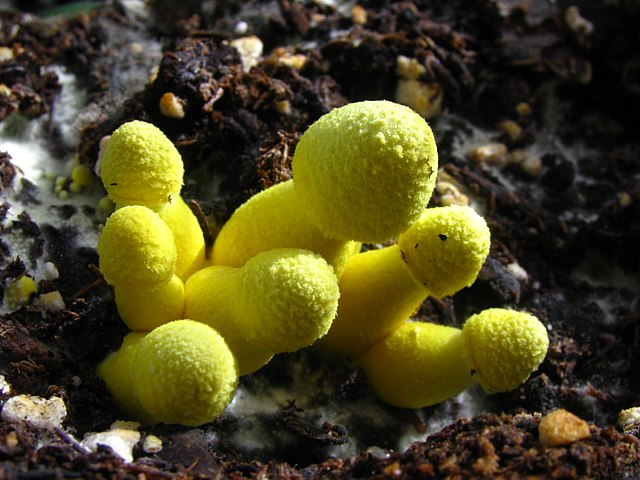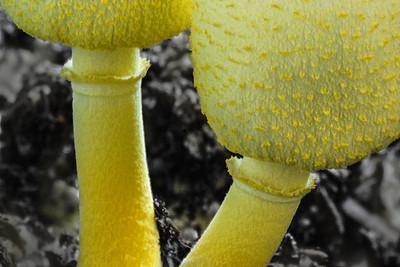Finding something strange in the soil of your houseplants can be a cause for anxiety. The presence of even the tiniest insects can spell doom for a plant, so it’s essential to take preventative measures as soon as possible. However, insects and worms aren’t the only unpleasant visitors to your plants or their soil. Read on and find out why are there mushrooms growing on my house plant.

Have you observed small spherical balls or caps popping out of your houseplant’s soil? Well, you’re not alone!
Fungi can also sometimes spontaneously grow in potting soil, much to the dismay of many people who love gardening or houseplants. And it’s from some of these fungi that mushrooms originate. A mushroom is the fruiting body of a fungus that grows above the ground and is fleshy with spore-bearing pockets.
Mushrooms on houseplants aren’t necessarily bad, but they could indicate overwatering, exceptionally fertile soil or that fungal spores have made their way inside the plant.
Mushrooms also grow in dark environments, so unless it is what your plant prefers, mushrooms are an indication that you should adjust your care practices and potentially repot your plants.
That said, there’s a lot more to mushrooms in houseplant soil. Read on to find out!
What Causes Mushrooms In Houseplant Soil?

If your plant’s soil has mushrooms, it’s an indication of a happy, thriving mini-ecosystem.
It seems as though many different kinds of mushrooms spring up overnight in the soil of a garden, and they grow and spread pretty quickly.
However, in actuality, these fungi require a few days to develop in your houseplants‘ soil while completely concealed from your view. Mushrooms can grow from various sources, including spores in the air or the potting mix you use, provided the conditions are suitable.
And although it is very impossible to trace how the spores got into your pot, the following are some of our best assumptions about it:
Spores In Your Potting Mix
If the soil-free potting mix has not been sterilized, there is a possibility that it contains mushroom spores.
When you add this to the soil in which your houseplant is growing, the spores begin to germinate and grow when the circumstances are warm and humid.
Alternatively, it’s possible that you brought the spores inside the house on your clothing, and they eventually made their way into the soil of your houseplant.
Spores In The Air
The most plausible explanation for the presence of mushrooms in your soil is that in the vicinity of your plant, mushroom spores were in the air, and some of them made their way into the container where your plant was growing.
This might have happened at any stage, such as when the soil was being sourced, at the plant store where you purchased it, or at the nursery where the plant was being grown.
Warm And Humid Conditions
The optimal conditions for mushroom growth are a relative humidity greater than 90 percent and a temperature of about 95 degrees Fahrenheit.
There’s a good chance that the mushroom spores in your potting mix or houseplant soil have been dormant for the past few months, waiting for the ideal conditions to appear and for them to germinate. And when conditions are right, these spores will germinate and develop into mushrooms.
Related: How To Get Rid Of Mushrooms In Lawn | Are Mushrooms Harmful To Grass?
What Type Of Mushroom Is That?

Leucocoprinus birnbaumii, previously Lepiota lutea, is the most common fungus in potting soil.
One of the most frequent types of mushroom to grow in potting soil is Leucocoprinus birnbaumii, formerly known as Lepiota lutea.
These mushrooms emerge from the ground in the form of tiny, bright yellow spheres at first. These teeny-tiny little gems range in height from about 1 to 2 inches and have an oval crown on top.
The cap then matures into the shape of a bell, and if you are a skilled observer, you might notice that the cap has intriguing lines and bumps in fascinating patterns. Again, this can be seen on the cap if you are an adult.
Also, the mushroom’s gills, which are responsible for the increased surface area of the cap, are not joined to the stem. When the cap is opened, white spores are released into the air. The majority of these spores land on the ground, but a few are blown away by the wind.
After the spores have been released, the color of the cap begins to fade progressively, which is an indication that the spores have been discharged.
Are Mushrooms Dangerous To My Plants?

They compete with fungus gnats for food, not your plant; therefore, they won’t harm it.
In a word, the answer is no! This is not the case. Mushrooms acquire their sustenance, which allows them to survive, from decomposing things, not your plant; as a result, they won’t cause any harm to it.
The only drawback is that they may take up a lot of room in the container you plant them in. Also, they reproduce by spreading spores
So, if you have one mushroom, you’ll probably have many more in a short amount of time if you keep it around to such an extent that your pot can get full of them.
Also, when some plants or fungi are allowed to grow in close proximity to one another, the flavors of the resulting fruits can be altered.
However, if you have any poisonous mushrooms growing nearby, don’t worry; they won’t poison your houseplant fruit or alter its taste.
Related: Mushrooms In Houseplants? This is Why They Are A Good Sign
Are Mushrooms Dangerous To Me And My Pets?

Although airborne mushroom spores flourish in conditions comparable to mold, they don’t pose a health risk.
I can understand why some individuals have a phobia of mushrooms and believe that the mere touch of a mushroom can cause them to become ill or perhaps cause their death.
However, it is a fact that some of them are really poisonous, which means they might provide a significant risk to either you or your pet.
To become ill from them, however, you or your pet must consume them, just as is the case with other potentially hazardous compounds.
So, you should avoid eating the typical mushrooms that grow on houseplants to avoid being exposed to their toxic side because they are quite deadly.
Furthermore, since the spores might irritate the skin or create an allergic respiratory reaction, removing them using disposable gloves and a face mask is best.
Do I Need To Get Rid Of The Mushrooms?

Mushrooms can be unattractive and toxic to humans and dogs, but they won’t damage your yard.
Well, that is for you to decide! There’s no reason to get them if you don’t have any kids or if the sight of their fluorescent yellow color gives you the willies.
Mushrooms, however, have the propensity to multiply rapidly, and some people don’t like the way they look when they grow in containers. Moreover, data on how hazardous they are to humans are mixed.
Also, mushrooms provide no health risk unless they are ingested. So, if you have children or pets that might try to gnaw on a plant pot mushroom, removing them or relocating the plant so that it is out of reach of tiny hands or paws is recommended.
You should also be aware that it is actually pretty difficult to get rid of them, and doing so might require you to replace the potting soil of your plant completely.
Getting Rid Of Mushrooms In Houseplants Soil

The best method for getting rid of mushrooms is to scrape off the top layer of dirt and throw it away.
Getting rid of mushrooms that have taken up residence in the soil of houseplants is not impossible, despite the fact that it may be difficult.
Also, you could just let them grow, and if you really want to get creative, you could do things like strew a few figurines of animals or fairies around the area to make it look like an indoor forest garden.
Moreover, attempting to remove mushrooms from the soil of your houseplant won’t harm the plant unless you scrape the dirt and damage the plant’s roots in the process.
The following are some of the strategies that we believe will be most helpful to you in your fight against mushrooms growing in the soil of houseplants:
Scraping The Soil
To remove the soil, carefully scrape out a layer of the earth using a clean spoon. Next, place the topsoil in a plastic bag, secure the bag with a tie, and dispose of it. This will prevent the spores from spreading to other plants and causing damage.
Removing and replacing the top two inches of soil in the pot of your houseplants may help, but the mushrooms and fungus may return.
It is impossible to determine how far the spores have infiltrated the soil; thus, the possibility always exists that this will occur. However, if you scrape the soil now, this could reduce the number of mushrooms next summer.
Re-pot The Plant
To do this, take your houseplant from its container while paying close attention to avoid damaging it, and then dispose of as much old soil as possible.
After thoroughly cleaning the area around the faucet, use your fingers to flick away any dirt that may still be there carefully.
This is the simplest method for getting rid of the mushrooms, but there may still be spores clinging to the roots when you’re done, and those spores could eventually develop into fully-fledged mushrooms.
Removing Mushrooms By Hand
It is possible to prevent the development of mushrooms in soil that is used for indoor plants if the existing mushrooms are removed as soon as possible.
In addition, because mushrooms spread their spores when they come into contact with other indoor plants, doing this will also help prevent that from happening.
Pull the mushroom by its stem rather than its cap when you are removing it from the soil surrounding your houseplant. If you pull it by the cap, the cap will break in two, and you will not be able to take the stem along with it.
Treating The Soil With Fungicide
In spite of the fact that the mushrooms can be physically removed, the spores should be your primary concern. It is quite challenging to eradicate the spores and mycelium from the soil, both of which could potentially lead to the development of new mushrooms at some point in the future.
Fumigating the houseplant’s soil with fungicide can be an option for killing the mushrooms and their spores. However, in order to eradicate the fungus and any spores it may have produced, the soil in your houseplants may need to be treated more than once.
In addition, fungicides should only be utilized when all other options have been exhausted. However, if you do decide to go in this direction, Bonide Fung-Onil is the option that will get you the most positive outcomes.
Final Thoughts
Fungi are the culprit in the case of mushrooms appearing on houseplants. That fungus’s fruit is mushrooms. One of the most common mushrooms to grow on houseplants is the Leucocoprinus birnbaumii. This mushroom is pale yellow in color and, depending on its level of maturity, may have a ball or flat cap.
However, mushrooms sprouting in your houseplants are not necessarily bad; it could be a symptom of overwatering, particularly fertile soil, or even just that some spores got into your plant somewhere along the road.
They won’t be harmful to your plant in any way. But, unfortunately, they can quickly spread, so eliminating them is probably a good idea. The most straightforward approach would be to scrape off the mushrooms and the top centimeter of soil.
On the other hand, if the mushrooms keep coming back, you might wish to replace the soil around the plant thoroughly.
Frequently Asked Questions
How do I permanently get rid of mushrooms?
If you want to remove mushrooms permanently, stir together two tablespoons of baking soda with one gallon of water and continue until the baking soda is completely dissolved.
Then, apply the mixture to the mushrooms and the soil around them using a spray bottle. This will, in time, restrict the mushrooms’ growth and possibly even cause their death.
What do you do with mushrooms in the soil?
If you have mushrooms in your houseplant soil, just gather them up and bury them in the compost pile when you’re done.
However, you should prepare for another harvest since they will begin producing new fruiting bodies in about a day and a half. Fungicide chemicals used to kill mushrooms may also be ineffective since the fungal mycelium can be found many feet below the soil’s surface.
Does baking soda kill mushrooms?
Baking soda, when combined with water, becomes a fungicide that can be used to aid in the elimination of mushrooms.
When everything is done properly, you may anticipate that the mushrooms will perish in around three to four days. It does this by increasing the alkalinity of the soil, which mushrooms cannot tolerate, and thus end the mushroom growth.
Why do I have so many mushrooms in my yard?
Mushrooms suggest a high concentration of organic matter in the soil in your yard. It takes just the proper temperature and humidity for a mushroom to sprout.
Such as, for instance, extended spells of damp, warm, and humid weather. However, a few mushroom patches on the grass are not necessarily a bad thing; in fact, they are always good!
Should I get rid of mushrooms in my garden?
Our natural inclination may be to get rid of mushrooms, yet those that pop up in the yard or garden are actually indicators of rich, organic soil.
Also, while mushrooms may be a nuisance if they pop up in your yard or garden, they often aren’t harmful to the grass, soil, or plants there. So, in general, the answer is that mushrooms in your garden are okay.
Why is my dirt growing mushrooms?
Mushrooms could have originated from another plant in your house, or they could have been brushed off your clothes.
Giving your indoor plants an excessive amount of water almost always results in the growth of mushrooms in the potting mix or organic matter you use. They are most productive during the summer when the soil is both moist and warm.
Will vinegar stop mushrooms from growing?
You can get rid of the mushrooms growing in your yard by using a ready-made fungicide, or you can make your own fungicide by mixing vinegar and water.
Either way, you have options. Vinegar contains an active component known as acetic acid, and research has shown that acetic acid is quite effective at eliminating garden mushrooms.
Sources For Further Reading
One of my houseplants has small, yellow mushrooms on the surface of the potting soil. Will the mushrooms harm it? (2022). Retrieved 26 October 2022, from https://hortnews.extension.iastate.edu/faq/one-my-houseplants-has-small-yellow-mushrooms-surface-potting-soil-will-mushrooms-harm-it
General | Fungi in potting soil. (2022). Retrieved 26 October 2022, from https://plantvillage.psu.edu/posts/6522-general-fungi-in-potting-soil
Algae and Fungal Growth on the Soil of Indoor Plants | University of Maryland Extension. (2022). Retrieved 26 October 2022, from https://extension.umd.edu/resource/algae-and-fungal-growth-soil-indoor-plants
Editor’s Recommendations
The Monstera Is Loose! How To Save Your Droopy Plant
How To Propagate And Care For Prayer Plants | A Comprehensive Guide
How To Save An Overwatered Peace Lily From Dying? A Comprehensive Guide







